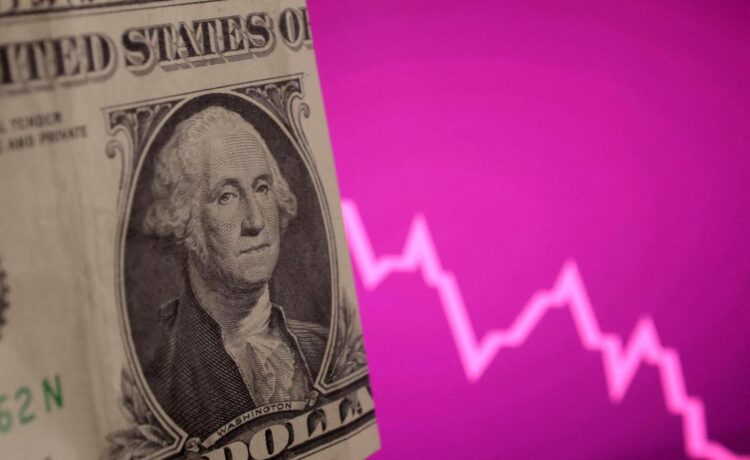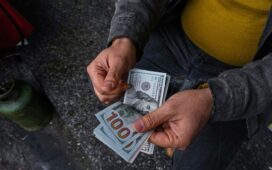TOKYO – Asian stock markets fell on April 11 as an escalating trade war between the world’s two biggest economies saw frantic sell-offs hit US assets on growing recession fears.
Japan’s Nikkei index was down 3.8 per cent, having soared 9.1 per cent the previous day after US President Donald Trump paused many tariffs for 90 days.
South Korea’s Kospi fell 0.9 per cent and Australia’s ASX200 lost 1.4 per cent, but Taiwan’s TAEIX index rose 1.5 per cent, reversing a 2.5 per cent drop.
Singapore stocks were not spared with the Straits Times Index down 2.1 per cent at midday, after dropping 3.1 per cent soon after trading began.
Chinese shares earlier snapped a three-day winning streak after the US said its tariffs on China amounted to a staggering 145 per cent. The Shanghai Composite later edged up 0.1 per cent as traders focused on possible Beijing stimulus measures. Hong Kong’s Hang Seng Index rose 0.6 per cent.
The US dollar extended losses after the Bloomberg Dollar Spot Index fell 1.5 per cent overnight, its biggest plunge in three years. Waning confidence in the US economy prompted investors to ditch US assets to the benefit of safe havens like the Swiss franc, yen and euro, as well as gold.
The US currency dropped as much as 1.2 per cent to 0.81405 Swiss franc for the first time since January 2015, extending the previous day’s nearly 4 per cent plunge. It slid 0.9 per cent to 143.10 yen, the weakest since Oct 1.
The euro surged as much as 1.7 per cent to US$1.13855, a level last seen in February 2022.
The US dollar also weakened against the Singapore dollar, trading down 0.3 per cent to 1.3265 as at 12.13pm Singapore time. The Singdollar has gained roughly 3 per cent against its American counterpart in 2025.
Tariffs were expected to boost the US dollar, but instead the currency has fallen more than 7 per cent since Mr Trump’s inauguration in January, and more than 2 per cent since he unveiled global tariffs on April 2.
The decline for the US dollar has come along with sell-offs in US stocks and bonds as foreign investors respond to Mr Trump’s protectionist policies by dumping US assets amid rising worries of a recession.
The sell-off in US Treasuries picked up pace during Asian hours, with the 10-year note yield rising to 4.45 per cent, gaining about 45 basis points in the week, the biggest increase since 2001, LSEG data showed. The rising yields threaten to deal the economy another jolt by pushing up the cost of borrowing across the financial system.
Overnight, the US S&P 500 Index plunged 3.5 per cent as investors seized on April 9’s historic market rebound to sell.
In a measure of how volatile markets have become since Mr Trump announced his plan to impose punitive tariffs on dozens of America’s trading partners, the S&P 500’s gyrations in the past two trading sessions have rivalled those unleashed by the Covid-19 pandemic and the 2008 financial crisis.
The moves, in the end, all pointed towards the same sobering conclusion: Mr Trump’s chaotic tariff roll-outs – regardless of where they eventually settle – are rapidly undermining confidence in the US economy and threatening to keep markets on edge for the next three months as traders wait to see how it will all play out.
“The reality of this being over quick and us returning to happy days quickly is very, very low,” said Mr Bill Smead, chief investment officer at Smead Capital Management. “This is the beginning of a monstrous bear market.”
This fear is indicative of how much sentiment has shifted less than three months into Mr Trump’s second term, one that Wall Street once wagered would fuel the stock market’s bull run by slashing taxes, rolling back regulation and driving the economy’s growth.
But these expectations have rapidly reversed as Mr Trump moved to fire tens of thousands of employees, withheld federal aid and moved to single-handedly rewrite the rules of global trade in America’s favour.
As much as the tariffs themselves, concerns have deepened because of the President’s approach – including on-and-off again roll-outs, unusual formulas used to set them, an unorthodox objective, and his decision to keep escalating the conflict with China, which instead of being exempted from April 9’s reprieve was hit with another round of retaliation.
This has made it difficult for analysts to forecast how it will all play out, much less reckon what it will ultimately mean for the prices of stocks, bonds and commodities.
Meanwhile, the trade war is still threatening to break supply lines, cut cross-border trade and deliver another inflation shock to US consumers as imports grow more expensive. All of that has left Wall Street increasingly worried that the economy will stall.
“We will get a recession, because that is what the trade war will create,” Ms Que Nguyen, chief investment officer of equity strategies at Research Affiliates. “And he (Trump) won’t back off unless we get to the brink of a depression. So equity markets are rationally pricing in a recession.”
Ms Jamie Patton, co-head of global rates at the TCW Group, said: “It’s hard to imagine the worst is behind us. Risk assets don’t like uncertainty and volatility, and that’s exactly what this administration is giving us.” BLOOMBERG, REUTERS
Join ST’s Telegram channel and get the latest breaking news delivered to you.




